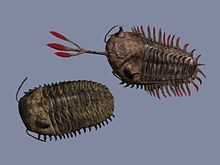Phacopida
| Phacopida Temporal range: Tremadocian to Famennian | |
|---|---|
 | |
| Dalmanites limulurus, a trilobite of the suborder Phacopina | |
| Scientific classification | |
| Kingdom: | Animalia |
| Phylum: | Arthropoda |
| Class: | Trilobita |
| Order: | Phacopida Salter, 1864 |
| Suborders | |
| |
Phacopida ("Lens-face") is an order of trilobite that lived from the Ordovician to the Devonian. It is made up of a morphologically diverse group of related suborders.
The origin of the Phacopida order is uncertain. It comprises three suborders (Phacopina, Calymenina, and Cheirurina) which share a distinctive protaspis (developmental stage lacking segments) type. The Cheirurina and Calymenina retain a rostral plate (an apomorphy) but in virtually all Phacopina the free cheeks are yoked as a single piece. This sort of similarity in development suggests phylogenetic unity. The suborder Calymenina is the most primitive of the Phacopida order and shares some characteristics with the order Ptychopariida, though it is not included in the subclass Libristoma.

Phacopida had 8 to 19 thoracic segments and are distinguishable by the expanded glabella, short or absent preglabellar area, and schizochroal (Phacopina) or holochroal (Cheirurina and Calymenina) eyes. Schizochroal eyes are compound eyes with up to around 700 separate lenses. Each lens has an individual cornea which extended into a rather large sclera.
The development of schizochroal eyes in phacopid trilobites is an example of post-displacement paedomorphosis. The eyes of immature holochroal Cambrian trilobites were basically miniature schizochroal eyes. In Phacopida, these were retained, via delayed growth of these immature structures (post-displacement), into the adult form.
Phacops rana and Dalmanites limulurus are two of the most well-known members of this order. Other known phacopids include Cheirurus, Deiphon, Calymene, Flexicalymene and Ceraurinella.
| ||
| ||
| ||
| ||
| Image of Phacopidan Trilobite Calymene tristani in nodule. |
References
- ↑ "Colpocoryphe grandis". Trilobite systematics. Retrieved 21 August 2011.
